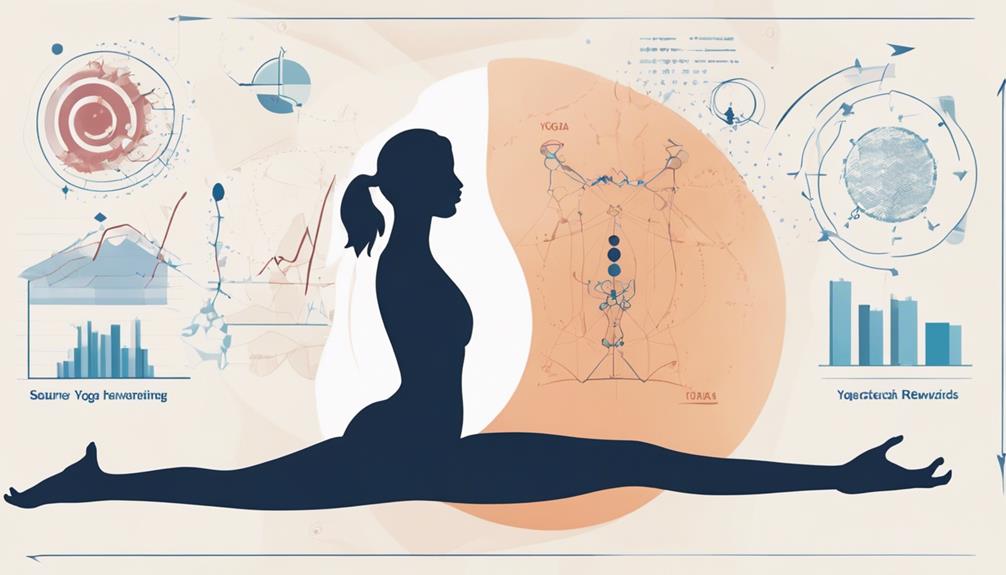The Science of Yoga: The Risks and the Rewards by William J. Broad – Summary and Review

'The Science of Yoga: The Risks and the Rewards' by William J. Broad delves into the benefits and dangers of yoga. It offers a comprehensive view of this ancient practice in light of modern scientific scrutiny. Broad's exploration covers the impact on physical health and mental well-being.
The book provides valuable insights for those interested in the intricate relationship between yoga, mind, and body.
Key Takeaways
- Yoga balances physical benefits with risks for optimal well-being
- Broad explores positive and negative effects of yoga
- Mind-body connection enhances emotional resilience and clarity
- Broad encourages informed, mindful approach to yoga practice
Key Insights From 'The Science of Yoga
In exploring the key insights from 'The Science of Yoga,' one discovers a profound intertwining of ancient wisdom with modern scientific understanding. The Science of Yoga delves into the intricate workings of the human body and mind, shedding light on how the practice affects our physical, mental, and emotional well-being. Through a combination of rigorous research and anecdotal evidence, it becomes evident that yoga isn't merely a physical exercise but a holistic approach to harmonizing the body and mind.
Key insights from this exploration reveal that yoga has the remarkable ability to reduce stress, lower blood pressure, and improve overall cardiovascular health. Moreover, the practice of yoga enhances flexibility, strength, and balance while also fostering a sense of inner peace and mindfulness. By delving into the science behind yoga, one gains a deeper understanding of its profound benefits and transformative power.
The Science of Yoga serves as a bridge between ancient traditions and modern science, offering a wealth of knowledge for those seeking physical, mental, and emotional liberation through the practice of yoga.
Benefits of Practicing Yoga
Beginning on a journey into the domain of yoga uncovers a multitude of profound benefits that extend beyond the physical world, encompassing mental clarity, emotional resilience, and spiritual growth. The practice of yoga not only enhances physical flexibility but also serves as a powerful tool for stress relief. Through a series of carefully curated poses and mindful breathing, individuals can experience a deep sense of relaxation and release tension accumulated from the demands of daily life. This ancient discipline offers a pathway to inner peace and emotional well-being, allowing practitioners to navigate the complexities of modern existence with grace and equanimity.
| Benefits of Yoga | Emotions Evoked |
|---|---|
| Increased flexibility | Joy |
| Stress relief | Calmness |
| Mental clarity | Serenity |
| Emotional resilience | Empowerment |
Risks Associated With Yoga
Starting on the path of yoga may involve certain risks that require practitioners to approach the practice with mindfulness and awareness. While yoga offers a myriad of benefits, it's vital to acknowledge the potential risks associated with it.
Injury prevention should be a top priority for yogis, emphasizing the importance of proper technique to avoid overexertion and muscle strain. Practitioners must listen to their bodies, honoring their limits, and gradually progressing in their practice to prevent injuries. Pushing too hard or attempting advanced poses without mastering the basics can lead to strains or sprains.
It's important to find a qualified instructor who can guide students in alignment and technique, reducing the risk of injury. By practicing yoga mindfully, individuals can reap the rewards of this ancient practice while minimizing the chances of experiencing setbacks. Remember, the essence of yoga lies in finding balance and harmony within oneself, both physically and mentally.
Scientific Evidence on Yoga
Yoga has been the subject of numerous scientific studies, shedding light on its physical and mental health benefits. Researchers have found evidence supporting yoga's positive impact on flexibility, strength, stress reduction, and overall well-being.
It's important to also consider safety precautions and guidelines when engaging in yoga practices to maximize its benefits and minimize risks.
Yoga's Physical Benefits
With a wealth of scientific evidence supporting its physical benefits, yoga stands as a practice that not only enhances flexibility and strength but also promotes overall well-being.
Flexibility benefits from yoga are well-documented, with poses and stretches improving range of motion and reducing the risk of injuries. Strength training is another key aspect of yoga, with various poses requiring engagement of different muscle groups, leading to increased muscle tone and endurance.
Studies have shown that regular yoga practice can lead to improvements in balance, posture, and overall physical fitness. The holistic approach of yoga not only focuses on the body but also integrates breathing techniques and mindfulness, making it an all-encompassing practice for physical well-being.
Mental Health Benefits
Enhancing not only physical well-being but also mental health, scientific evidence on yoga reveals a profound impact on one's psychological state. Through the mind-body connection that yoga nurtures, individuals experience significant stress relief, fostering emotional resilience and enhancing cognitive function.
The practice of yoga has been shown to reduce levels of cortisol, the stress hormone, thereby promoting a sense of calm and well-being. This ancient discipline not only strengthens the body but also empowers the mind, offering practitioners a holistic approach to health and wellness.
Safety Precautions
Amidst the myriad benefits attributed to the practice of yoga, scientific evidence underscores the importance of implementing safety precautions to maximize its potential advantages while minimizing risks.
- Prioritize Alignment: Ensuring proper alignment in poses is essential to prevent injuries and promote safe practices.
- Listen to Your Body: Encouraging practitioners to listen to their bodies and respect their limits can help prevent overexertion and strain.
- Qualified Instructors: Choosing certified instructors who prioritize student safety and provide modifications when needed can enhance the overall yoga experience.
Impact on Physical Health
Yoga's impact on physical health encompasses a spectrum of benefits and potential risks that individuals need to contemplate. It offers advantages such as improved flexibility, strength, and overall well-being, yet practitioners must also be mindful of potential injuries or exacerbation of existing health conditions.
Understanding these dual aspects can guide individuals in harnessing the positive effects of yoga while mitigating any associated risks.
Yoga Benefits Physical Health
Numerous studies have demonstrated that regular practice of yoga contributes greatly to enhancing one's physical health and overall well-being.
- Increased Flexibility: Yoga poses focus on stretching and lengthening muscles, leading to improved flexibility and range of motion, allowing individuals to move more freely in their daily activities.
- Strength Building: The various poses in yoga help build muscle strength, contributing to better posture and overall physical fitness.
- Stress Reduction: Through mindful breathing and meditation techniques, yoga aids in reducing stress levels, which in turn can have a positive impact on physical health by lowering blood pressure and improving cardiovascular function.
Yoga truly offers a holistic approach to physical fitness, promoting both strength and relaxation.
Potential Health Risks
When considering the practice of yoga, it's essential to acknowledge the potential health risks that may impact physical well-being. While yoga offers numerous benefits, such as increased flexibility and strength, there are risks that need to be addressed.
Injury prevention is vital, and practitioners must focus on proper alignment to avoid strains or muscle imbalances. Understanding limitations and listening to the body are key components in maintaining a safe yoga practice.
Pushing beyond one's capabilities can lead to injuries, so it's important to approach each session with mindfulness and respect for personal boundaries. By staying attentive to proper alignment, recognizing individual limitations, and honoring the body's signals, practitioners can enjoy the rewards of yoga while minimizing potential health risks.
Influence on Mental Well-being
Indisputably, the practice of yoga holds profound influence on one's mental well-being, offering a pathway to inner peace and emotional resilience. Through the mind-body connection fostered by yoga, individuals can attain emotional stability and a sense of centeredness that permeates their daily lives.
The following three aspects illuminate the transformative power of yoga on mental well-being:
- Stress Relief: Yoga serves as a sanctuary where individuals can release the tensions of daily life, allowing for a deep sense of relaxation and calmness to prevail. This release of stress contributes to a clearer mind and a more positive outlook on life.
- Mindfulness Practices: By engaging in mindfulness techniques during yoga practice, individuals learn to focus on the present moment, cultivating a sense of awareness that extends beyond the mat. This heightened awareness can lead to a greater appreciation for life's simple joys and a reduction in anxiety.
- Emotional Resilience: Yoga empowers individuals to navigate challenges with a newfound sense of strength and resilience. Through the practice of yoga, individuals can develop the emotional fortitude to face life's ups and downs with grace and composure.
Critique of William J. Broad's Work
Broadly scrutinizing William J. Broad's work reveals a nuanced perspective on the intersection of science and yoga. In conducting a critical analysis of Broad's writing, it becomes evident that his work navigates the complex terrain of yoga's impact with a blend of scientific inquiry and journalistic storytelling. While some critics argue that Broad's approach may oversimplify the intricate relationship between yoga and its effects, others appreciate his efforts to bring attention to the potential risks and rewards associated with the practice.
Broad's work offers a unique vantage point, shedding light on both the positive and negative aspects of yoga through the lens of scientific research. His exploration of the author's perspective on the subject matter adds depth to the ongoing conversation surrounding yoga's influence on physical and mental well-being. By delving into the nuances of this ancient practice with a critical eye, Broad challenges readers to reconsider their assumptions and approach yoga with a more informed perspective.
Frequently Asked Questions
Can Practicing Yoga Improve Cognitive Function and Memory?
Practicing yoga has been shown to positively impact brain health by improving cognitive function and memory. The combination of physical postures, breathing techniques, and meditation in yoga practice contributes to enhancing memory and overall mental sharpness.
How Does Yoga Impact Emotional Regulation and Stress Management?
Yoga fosters emotional well-being by enhancing self-awareness and promoting relaxation. Through mindful movement and breath work, it equips individuals with tools for stress relief, aiding in emotional regulation and creating a sense of calm.
Are There Any Specific Guidelines for Beginners to Minimize the Risk of Injury While Practicing Yoga?
To minimize injury risks, beginners should focus on proper alignment, breath, and gradual progression. Implementing modifications for individual needs enhances safety. Embrace the journey without rushing, listen to the body, and honor its limits.
What Are Some Common Misconceptions About the Scientific Evidence on the Benefits of Yoga?
Common misconceptions about the scientific evidence on the health benefits of yoga often stem from limited understanding of the nuances of research findings. It's essential to approach scientific studies on yoga with a discerning eye.
How Does the Cultural and Historical Context of Yoga Influence Its Modern Practice and Perception?
Cultural influences shape the essence of yoga, weaving history into modern practices. These roots foster a diverse perception, blending tradition with contemporary needs. Understanding this dynamic interplay enriches the practice, offering wisdom and unity.










